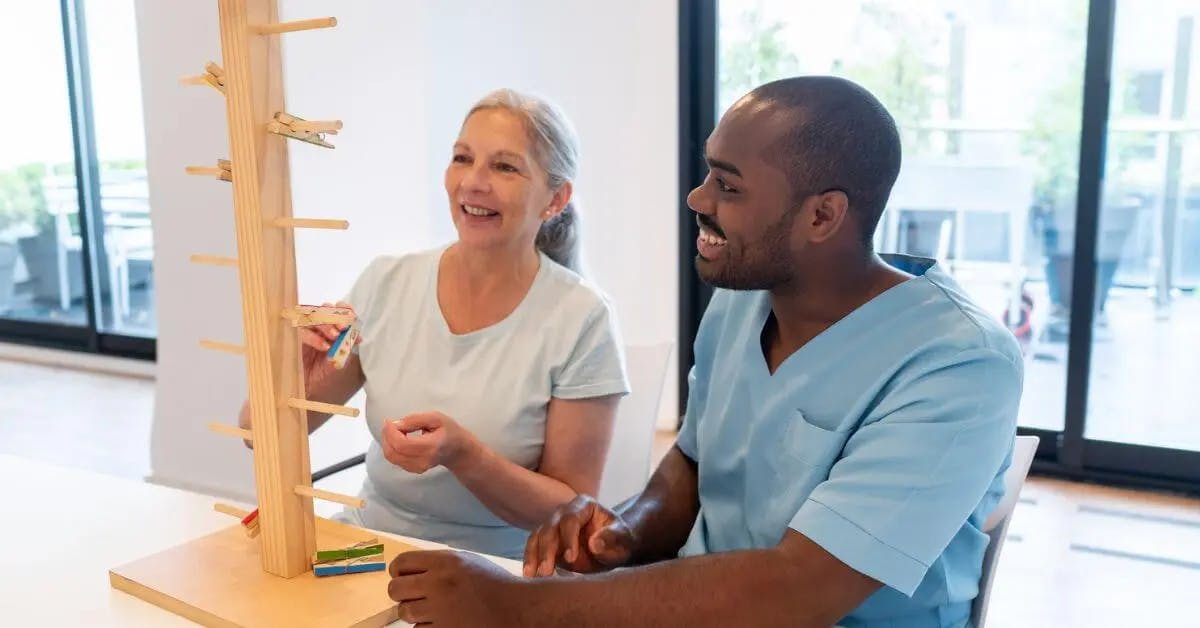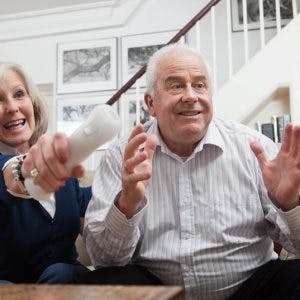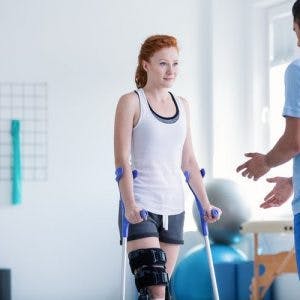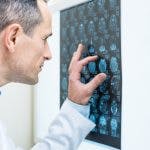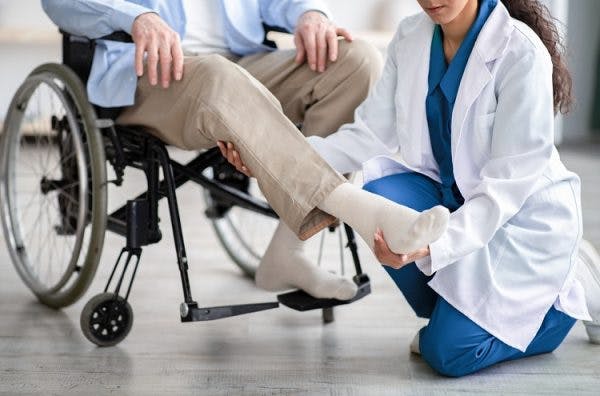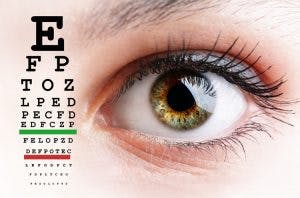A stroke can significantly impact your life, affecting your ability to perform everyday tasks. Occupational therapy (OT) plays a vital role in helping stroke patients regain independence and improve their quality of life.
This comprehensive guide explores the benefits of occupational therapy for stroke patients, the types of treatments offered, and what to expect during your recovery journey.
Jump to a section:
Understanding the Role of Occupational Therapy After a Stroke
What to Expect During Occupational Therapy
Occupational Therapy Interventions for Stroke Patients
Occupational Therapy Exercises for Stroke Patients
Tips for Maximizing Occupational Therapy Benefits
How To Find an Occupational Therapist
Understanding the Role of Occupational Therapy After a Stroke
Occupational therapy focuses on helping individuals participate in their occupations. While this may include job skills, an “occupation” is considered anything that “occupies” your time.
Therefore, occupational therapy for stroke patients focuses on improving participation in meaningful activities. This may include the activities of daily living, such as dressing, bathing, cooking, and cleaning. Occupational therapists may also focus on improving the ability to work, drive, and even participate in leisure activities.
Promoting participation and independence in valued activities may involve addressing the cognitive and/or physical effects of stroke through therapeutic exercises and activities. Furthermore, occupational therapists may introduce adaptive equipment or recommend ways to modify tasks or the environment to improve participation.
How Occupational Therapy Helps Stroke Patients
Occupational therapists work together with stroke patients to identify and achieve a variety of goals that contribute to their overall well-being and independence. By addressing physical, cognitive, and emotional barriers to participation, occupational therapists can help stroke survivors regain the ability to perform daily activities as safely and independently as possible.. Here’s a closer look at how OT helps:
- Improve physical function: This includes regaining strength, coordination, and balance through targeted exercises and activities. This might involve improving mobility, restoring range of motion, and enhancing fine and gross motor skills. Furthermore, OTs may also address sensation and visual changes.
- Enhance cognitive skills: This may include improving memory, attention, problem-solving, and decision-making abilities. These skills are crucial for daily functioning and safe community integration.
- Adapt daily tasks: OTs teach patients new ways to perform activities by using adaptive equipment or modifying their environment. This enables them to participate in daily routines and maintain their independence.
- Promote emotional well-being: Stroke can be emotionally challenging. OTs provide support and coping strategies to help patients adjust to their new reality and manage any emotional difficulties they may face.
- Facilitate community reintegration: OTs help patients return to work, driving, social activities, and hobbies they enjoyed before their stroke. This helps them regain a sense of normalcy and purpose.
By focusing on these areas, occupational therapy empowers stroke patients to live fulfilling lives and actively participate in their homes and communities.
The Importance of Early Intervention
Early intervention with occupational therapy after a stroke is crucial for optimizing recovery and maximizing functional outcomes. The sooner you begin therapy, the better your chances of regaining lost skills and adapting to your new reality.
Research indicates that starting OT soon after a stroke can lead to:
- Better functional outcomes: Early intervention can help prevent complications, promote neuroplasticity (the brain’s ability to rewire itself), and maximize your potential for recovery. In fact, the brain experiences a heightened level of neuroplasticity in the first few months following stroke, so early intervention can optimize gains in this timeframe.
- Faster return to independence: Addressing challenges early on can accelerate your progress and enable you to regain independence in daily activities sooner.
- Reduced long-term disability: Early OT can minimize the long-term impact of a stroke and reduce the likelihood of developing chronic disabilities.
- Improved wellbeing: Improving the ability to participate in valued daily activities early in the recovery process promotes an overall sense of wellbeing.
If you or a loved one has recently experienced a stroke, don’t delay seeking occupational therapy services. Early intervention can make a significant difference in your recovery journey.
What to Expect During Occupational Therapy
Your occupational therapy journey will be tailored to your specific needs and goals, taking into account the severity of your stroke and your individual priorities. The process typically involves several key stages:
- Evaluation: Your occupational therapist will conduct a comprehensive assessment to understand your strengths, challenges, and goals. This may involve physical assessments, cognitive tests, and interviews to gather information about your daily routines and desired outcomes.
- Goal Setting: You’ll collaborate with your therapist to set realistic and achievable goals for your recovery. These goals will guide your therapy sessions and provide a framework for measuring progress.
- Intervention: Your therapist will design a personalized treatment plan that may include exercises, activities, adaptive strategies, and environmental modifications. This plan will evolve as you progress and achieve your goals.
- Home Program: You’ll receive a home exercise program to continue practicing outside of therapy sessions. This is a crucial component of your recovery, as consistent practice is essential for optimizing neuroplasticity and maximizing gains.
- Progress Monitoring: Your therapist will regularly assess your progress and adjust the treatment plan as needed. This ensures that your therapy remains challenging and relevant to your evolving needs.
- Discharge Planning: When you’re ready to transition out of therapy, your therapist will provide recommendations for ongoing support and resources. This may include community programs, support groups, or adaptive equipment suppliers.
Throughout this process, your occupational therapist will act as your guide and advocate, supporting you in your journey toward recovery and independence.
Occupational Therapy Interventions for Stroke Patients
Occupational therapists use a variety of techniques and approaches to address the unique needs of each stroke patient. These interventions are designed to be holistic, addressing both the physical and cognitive effects of a stroke. Some common interventions include:
1. Activities of Daily Living (ADL) Retraining
ADLs are essential tasks we perform daily, and regaining the ability to perform these tasks is a primary focus of occupational therapy after a stroke. This involves breaking down tasks into smaller steps and gradually increasing complexity as the patient progresses. Here are some examples of ADL retraining:
- Dressing: Learning techniques to dress independently, even with limited mobility. This could involve using specific dressing techniques, adaptive clothing or assistive devices.
- Bathing and Grooming: Adapting bathing routines to enhance independence and safety and finding ways to manage grooming tasks. This might include practicing getting into and out of the shower, or using shower chairs, long-handled sponges, or modified toothbrushes.
- Toileting: Regaining independence with toileting activities. This may involve using assistive devices or modifying the bathroom environment with safety aids such as grab bars.
- Eating: Improving fine motor skills and coordination to eat without assistance. This might include using adaptive utensils or practicing specific eating techniques.
Regaining independence in ADLs is crucial for improving self-esteem and quality of life after a stroke.
2. Cognitive Rehabilitation
Cognitive rehabilitation focuses on improving cognitive skills affected by stroke. This often involves structured exercises and strategies to challenge and stimulate the brain. Here are some areas addressed in cognitive rehabilitation:
- Attention and Concentration: Using exercises and strategies to enhance focus and attention span. This might include computer-based programs, puzzles, or mindfulness techniques.
- Memory: Implementing techniques to improve memory recall and retention. This could involve memory games, organizational strategies, or assistive technology.
- Problem-Solving: Working through real-life scenarios to develop problem-solving skills. This might involve role-playing, simulations, or practical exercises.
- Visual-Spatial Skills: Practicing tasks that challenge visual perception and spatial reasoning. This could include puzzles, construction activities, or computer-based programs.
Since these skills are vital for everyday activities, occupational therapists may also practice affected activities as a way of monitoring progress. For example, if the patient is having trouble with cooking due to impaired memory and attention, the therapist may assess progress in these skills by asking them to gather the ingredients and follow instructructions to prepare a specific food item, providing supervision and cues as needed.
By improving cognitive function, patients can enhance their safety, independence, and overall ability to participate in daily life.
3. Upper Extremity Rehabilitation
Stroke often affects arm and hand function, leading to weakness, impaired coordination, and reduced sensation. Since the arms and hands are used in such a wide range of daily activities, addressing reduced upper extremity function is essential. Occupational therapists use a variety of techniques to address impaired arm and hand functions, including:
- Improve strength and range of motion: Through therapeutic exercises and activities. This might involve using weights, therapy putty, or resistance bands; or practicing functional tasks like reaching into an overhead cupboard or grasping silverware.
- Enhance fine motor skills: By practicing tasks that require precise hand movements. This could include manipulating small objects, using tweezers, or engaging in activities like buttoning, zipping, and tying.
- Increase dexterity: Using tools and techniques to improve hand coordination. This might involve hand therapy balls, dexterity boards, specialized exercises, or rehabilitation devices such as the MusicGlove.
- Explore assistive devices: Recommending and training patients on using adaptive equipment. This could include splints, braces, adaptive utensils, or assistive technology for accessing computers or mobile devices.
The goal of upper extremity rehabilitation is to restore as much function as possible, enabling patients to perform daily tasks and engage in meaningful activities.
4. Splinting and Orthotics
Splints and orthotics are often used in stroke rehabilitation to support and protect affected limbs, promote healing, and improve function. They can be particularly helpful in managing spasticity, preventing contractures, and improving hand function. Here’s how they can help:
- Prevent contractures: Maintaining muscle length and joint flexibility. This is important for preventing prolonged and severe stiffness and maintaining range of motion.
- Reduce pain: Providing support and stability to affected limbs. This can help alleviate pain and discomfort, allowing for increased participation in therapy.
- Improve hand function: Positioning the hand for optimal grasp and release. This can facilitate functional use of the hand for activities like eating, dressing, and grooming.
Occupational therapists carefully assess the need for splinting and orthotics and provide customized solutions to meet individual needs.
5. Environmental Modifications
Adapting the home environment is crucial for ensuring safety and promoting independence after a stroke. Occupational therapists assess the patient’s home and recommend modifications to address potential challenges and support participation in daily activities:
- Improve safety: Installing grab bars and removing tripping hazards, such as rugs, cords, and clutter on the floor. This helps prevent falls and injuries, ensuring a safe living environment.
- Increase accessibility: Widening doorways and creating ramps for wheelchair access. This allows for easy movement throughout the home and promotes independence.
- Promote independence: Adapting the kitchen, bathroom, and living areas to facilitate daily tasks. This might involve rearranging furniture, installing adaptive equipment, or modifying work surfaces.
Environmental modifications can significantly impact a stroke patient’s ability to live safely and comfortably at home.
Occupational Therapy Exercises for Stroke Patients
Occupational therapists design personalized exercise programs to address specific needs and goals. These exercises are designed to be functional and engaging, often incorporating activities that simulate real-life tasks. Here are some examples of exercises commonly used in stroke rehabilitation:
1. Range of Motion Exercises
These exercises help maintain joint flexibility and prevent muscle stiffness, which can occur after a stroke due to decreased activity and muscle weakness. Regular range of motion exercises are essential for preserving mobility and preventing complications. Examples include:
- Shoulder flexion and extension: Raising the arm forward and backward.
- Elbow flexion and extension: Bending and straightening the arm.
- Wrist flexion and extension: Moving the hand up and down at the wrist.
- Finger flexion and extension: Making a fist and then straightening the fingers.
These exercises can be performed passively with assistance or actively by the patient, depending on their level of ability. These may be recommended to be practiced at home daily, especially for patients with spasticity.
2. Strengthening Exercises
Strengthening exercises are crucial for rebuilding muscle strength and improving motor control after a stroke. These exercises gradually challenge the muscles, promoting recovery and enhancing functional abilities. Examples include:
- Squeezing a stress ball: Improves grip strength.
- Lifting light weights: Increases arm and shoulder strength.
- Picking up small objects with a clothespin: Enhances fine motor skills and strength.
- Performing resistance exercises with bands: Builds strength throughout the upper body.
The intensity and complexity of strengthening exercises are adjusted based on the patient’s progress and tolerance.
3. Coordination Exercises
Coordination exercises focus on improving the ability to perform smooth, controlled movements. These exercises challenge hand-eye coordination, dexterity, and precision, which are often affected by stroke. Examples include:
- Stacking blocks or cones: Develops hand-eye coordination.
- Threading beads: Enhances fine motor skills and precision.
- Flipping cards: Improves finger dexterity.
- Using a pegboard: Increases hand-eye coordination and fine motor control.
Coordination exercises can be made more challenging by increasing the speed or complexity of the task.
4. Functional Task Practice
Functional task practice involves practicing everyday activities to improve performance and independence. This type of exercise bridges the gap between therapeutic activities and real-life situations, promoting generalization of skills and enhancing confidence. Examples include:
- Simulating meal preparation: Practicing cutting food, opening containers, and using utensils.
- Performing dressing tasks: Buttoning shirts, zipping zippers, and tying shoelaces.
- Engaging in grooming activities: Brushing hair, brushing teeth, and washing the face.
- Participating in leisure activities: Playing games, doing puzzles, or engaging in crafts.
Functional task practice helps patients regain the skills and confidence needed to participate in meaningful activities and live fulfilling lives.
Tips for Maximizing Occupational Therapy Benefits
Occupational therapy can be highly effective in stroke recovery, but your active participation and commitment play a crucial role in achieving optimal outcomes. Here are some tips to maximize the benefits of your therapy:
- Active Participation: Engage actively in therapy sessions and follow your home exercise program consistently. Consistent practice stimulates the brain, promoting lasting improvements.
- Open Communication: Communicate openly with your therapist about your challenges, concerns, and goals. This helps your therapist tailor your treatment plan to your specific needs.
- Positive Attitude: Maintain a positive attitude and focus on your progress, even if it’s gradual. Celebrate your achievements and stay motivated throughout your recovery journey.
- Support System: Involve your family and caregivers in your therapy journey for added support and encouragement. They may even be encouraged to attend therapy sessions occasionally to learn more about your needs and abilities. Having a strong support system can significantly impact your motivation and overall well-being.
- Patience and Persistence: Recovery from a stroke takes time and effort. Be patient with yourself and celebrate small victories along the way. Remember that consistency and perseverance are key to achieving your goals.
By following these tips, you can actively participate in your recovery and make the most of your occupational therapy experience.
How To Find an Occupational Therapist
Finding the right occupational therapist is an important step in your stroke recovery journey. You want to find someone who is experienced, compassionate, and dedicated to helping you achieve your goals. Here are some resources to help you find a qualified occupational therapist in your area:
- Your doctor: Talk to your doctor about a referral for occupational therapy. They can recommend therapists who specialize in stroke rehabilitation and are familiar with your specific needs.
- Online directories: Several online directories, such as Healthgrades and Vitals, allow you to search for healthcare providers, including occupational therapists. You can read reviews and compare qualifications to find a therapist who meets your needs.
- Word of mouth: If able, talk with other stroke survivors in your area and see if they have any recommendations.
When choosing an occupational therapist, consider the following factors:
- Therapy setting: Many therapists work in just one therapy setting, such as in home health or at an outpatient clinic. The best therapy setting depends on your abilities and stage of recovery, so talk with your doctor about the best therapists for your specific needs.
- Experience: Look for a therapist with experience working with stroke patients and a track record of successful outcomes.
- Approach: Consider their approach to therapy and whether it aligns with your preferences and goals.
- Communication: Choose a therapist who communicates effectively with you and your family and makes you feel comfortable and supported.
Take the time to research potential therapists to find the best fit for your needs. However, it is important to note that many clinics may not consistently keep the same therapist with each patient. If this is your preference, be sure to discuss that before beginning therapy.
Occupational Therapy Is Essential
Occupational therapy is an essential component of stroke rehabilitation, offering a personalized and holistic approach to recovery. By focusing on meaningful activities and adaptive strategies, OT empowers stroke patients to regain independence, improve their quality of life, and return to the activities they enjoy.
Remember, stroke recovery is a journey that requires dedication, perseverance, and a positive attitude. Occupational therapy can provide the guidance, support, and tools you need to navigate this path successfully. With the right interventions and a commitment to your recovery, you can achieve significant progress and reclaim your life after a stroke.
Don’t hesitate to contact your doctor to seek out occupational therapy services and embark on your journey toward a fulfilling and independent life.

